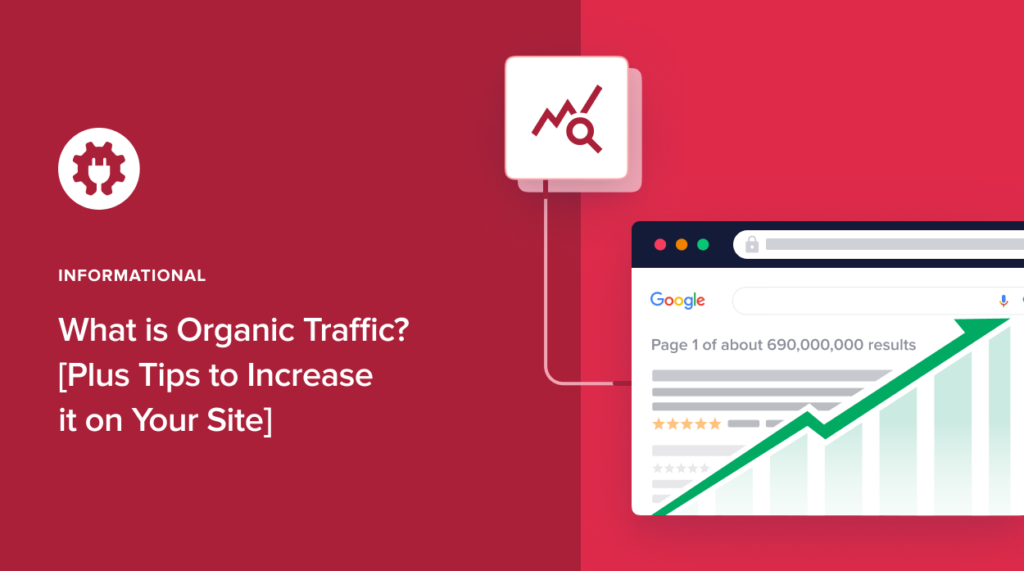What is organic traffic, and why should you be concerned about it?
If you have an online asset like a blog, eCommerce store, or niche site, you’ll want to drive traffic to it. After all, if people can’t find your site and visit it, all your efforts will go to waste. And the best type of traffic you want to drive is organic traffic.
In this article, we’ll show you what organic traffic is. We’ll even take it a step further and give you some tips on increasing the organic traffic to your site.
In This Article
- What is Organic Traffic? A Simple Definition in Plain English
- Why is Organic Traffic Important?
- How to Generate Organic Traffic for Your Website: 9+ Tips
- 1. Use the Right WordPress SEO Tool
- 2. Conduct Proper Keyword Research
- 3. Follow SEO Best Practices
- 4. Optimize for the Featured Snippet
- 5. Get Featured in the Google’s People Also Ask (PAA) Section
- 6. Boost Your Google E-E-A-T Signals
- 7. Build Strategic BackLinks
- 8. Combat Content Decay
- 9. Have a Content Marketing Strategy
- 10. Leverage Social Media Marketing
- 2 Organic Traffic Case Studies [Plus Takeaways]
- What is Organic Traffic? Your FAQs Answered
- What is Organic Traffic? Now that You Know, Optimize for It
What is Organic Traffic? A Simple Definition in Plain English
Organic traffic refers to visitors who come to your site by finding you on search engine result pages (SERPs). It’s free traffic as these visitors find your website by entering a search query into a search engine like Google, Bing, or Yahoo and then clicking on one of the organic (non-paid) search results.
Organic Traffic vs. Direct Traffic vs. Paid Traffic
As you learn about driving traffic to your site or check your traffic sources in tools like Google Analytics (GA), you’ll discover that there are 3 types of traffic that come to your site. These are organic traffic, direct traffic, and paid traffic.
What’s the difference between these 3?
The main differentiators are the source, acquisition, and cost. Here’s a brief look at how they differ:
Organic Traffic
- Source: Visitors who find your site through unpaid, natural search engine results.
- Acquisition: Users discover the website by entering a search query into a search engine and clicking on organic (non-paid) search results.
- Cost: No direct cost is associated with organic traffic. However, efforts like search engine optimization (SEO) are required to optimize a website for better search engine rankings.
Direct Traffic
Source: Visitors who directly type the website’s URL into their browser or use bookmarks.
Acquisition: Users are already aware of the website and navigate to it directly without using a search engine. It can also include traffic from links in your email newsletters and messaging apps. In Google Analytics (GA), it is defined as the traffic that comes to your site with no source or data.
Cost: Typically, there is no direct cost associated with direct traffic. It often represents existing users or those who have been referred by word of mouth.
Paid Traffic
Source: Visitors who come to a website through paid advertising.
Acquisition: Users click on paid ads, such as pay-per-click (PPC) advertisements on search engines or display ads on other websites.
Cost: You pay for your site/content to be displayed on top of the SERPs or on social media platforms. Not only that, but you pay for each click or impression, depending on the advertising model. Examples include Google Ads, social media advertising, and display advertising.
Other traffic types include referral traffic, which is traffic from other sites (via backlinks), and social traffic from links shared on social media.
Why is Organic Traffic Important?
As you’ve already seen, organic traffic is important because it’s cost-effective. But besides the fact that it’s free, it also has many other benefits, some of which include:
Credibility and Trustworthiness
Websites that appear in organic search results are often perceived as more credible and trustworthy by users. Many people trust the editorial integrity of these results over paid advertisements.
Sustainability
Organic traffic is sustainable over time. Once your site establishes a strong presence in search engine results through effective SEO, it can continue to attract organic traffic without ongoing advertising expenses.
Long-Term Value
The efforts you put into optimizing your site for organic search can have long-term benefits. Unlike paid advertising, which stops generating traffic when the budget runs out, organic traffic continues to flow even when SEO efforts are not actively pursued.
Higher Click-Through Rates (CTRs)
Studies have shown that search engine users are likelier to click on organic search results than paid ads. Plus, appearing in the top positions of organic search results can lead to higher click-through rates and increased visibility.
Builds Authority
Consistently appearing in organic search results over time can help you build authority in your niche. This can contribute to a positive brand image and increased trust among users.
How to Generate Organic Traffic for Your Website: 9+ Tips
The best way to generate organic traffic to your website is by implementing SEO best practices. Some of the
1. Use the Right WordPress SEO Tool
One of the first steps to increasing the organic traffic coming to your site is to use the right SEO plugin. And for WordPress users, there’s no better plugin than All In One SEO (AIOSEO).
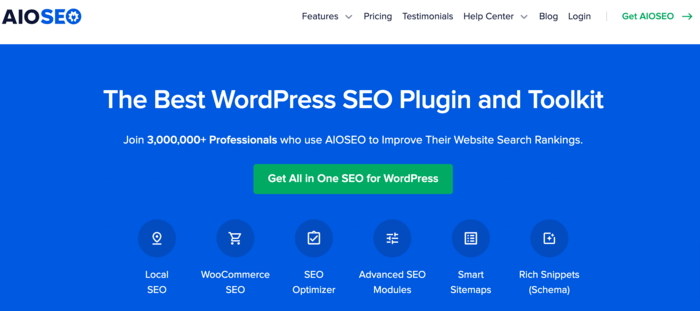
AIOSEO is a powerful yet easy-to-use SEO plugin that’s active on over 3 million websites. Millions of smart bloggers use AIOSEO to help them boost their search engine rankings and drive qualified traffic to their blogs. That’s because the plugin has many powerful features and modules designed to help you properly configure your SEO settings. Examples include:
- Cornerstone Content: Easily build topic clusters and enhance your topical authority and semantic SEO strategy.
- SEO Revisions: Track any changes you make to your site and see their impact on your SEO. Plus, you get to see on a timeline how Google updates affect your site.
- Advanced Robots.txt Generator: Easily generate and customize your robots.txt file for better crawling and indexing.
- TruSEO Highlighter: Makes it easy to spot on-page SEO issues and gives recommendations for fixing them.
- Next-gen Schema generator: This no-code schema generator enables users to generate and output any schema markup on your site.
- Redirection Manager: Helps you manage redirects and eliminate 404 errors, making it easier for search engines to crawl and index your site.
- Link Assistant: Powerful internal linking tool that automates building links between pages on your site. It also gives you an audit of outbound links.
- SEO Preview: This gives you an overview of your search and social snippets and general SEO so you can improve your optimization.
- IndexNow: For fast indexing on search engines that support the IndexNow protocol (like Bing and Yandex).
- Sitemap generator: Automatically generate different types of sitemaps to notify all search engines of any updates on your site.
- And more
AIOSEO also has many other features to help you boost your local SEO, on-page SEO, and technical SEO. And, if you’re a WooCommerce user, AIOSEO has a tailor-made WooCommerce SEO module to help you rank your online store higher in search rankings.
If you want to boost your organic traffic, the first step is to install AIOSEO. Check out our detailed installation guide for step-by-step instructions on how you can do that.
2. Conduct Proper Keyword Research
Proper keyword research is one of the most important steps to growing your organic traffic. It involves identifying the words and phrases your target audience uses to find your blog content, products, or services. There are many tools you can use for this, including Ahrefs, Semrush, and more.
If you’re in a competitive niche, you’ll have better success at targeting long-tail keywords as they have lower keyword difficulty.
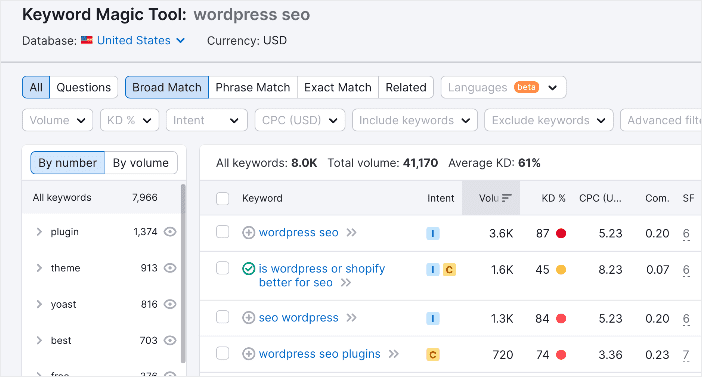
Check out our list of recommended keyword research tools here.
Besides finding the right keywords, you should know how to use them strategically. A few ways include adding your focus keyword to your:
- Headline
- SEO title
- Meta description
- Introduction and conclusion
- Headers (H1, H2, H3, etc.)
- URL
However, you should avoid keyword stuffing, which is the overuse of your keyword. Instead, opt for synonyms and other LSI keywords.
3. Follow SEO Best Practices
Another way of increasing your organic traffic is by following SEO best practices. SEO best practices encompass a wide range of strategies you can use to optimize your site for better rankings and conversion rates. Here are some essential SEO best practices that should be non-negotiable:
Ensure Proper Indexing of Your Content
Without proper indexing, your site and content will be invisible on the internet. Indexing is the process search engines use to analyze and store the information collected during the crawling process. The data is organized and added to Google’s index (or any other search engine) for easy retrieval when relevant searches are made.
Check out our tutorial on checking the index status of your content right inside your WordPress dashboard.
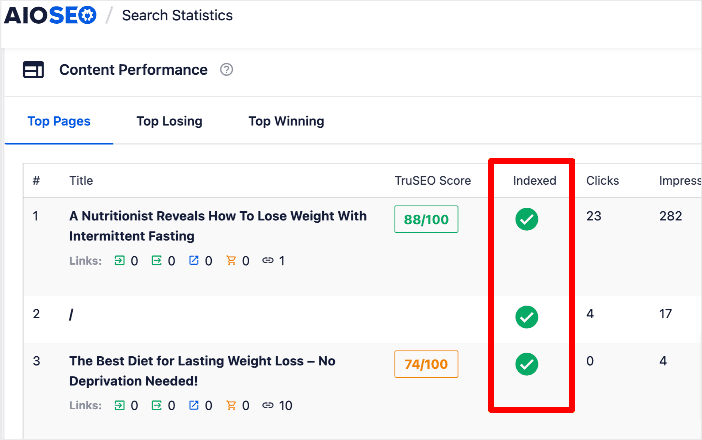
This powerful tool helps you know which content has been indexed. More importantly, it helps troubleshoot content that hasn’t been indexed yet.
SEO-friendly URLs
A URL, or Uniform Resource Locator, is a reference or address used to access resources on the internet. It’s your webpage’s address, making it a critical element in boosting your search visibility.
To ensure your URLs are SEO-friendly, you should include the target keyword, keep them short, and avoid numbers, among other best practices. Check out our tutorial on the best permalink structure for more information.
Don’t Neglect Metadata
Metadata in SEO refers to the information (HTML tags) that provides more details to search engines about the content on your posts or pages. There are several types of metadata. However, the 2 most important are SEO titles and meta descriptions.
These require creativity and time to get right because you should stick to a stipulated character count while effectively conveying your message. Thankfully, you can use AI to generate SEO-friendly metadata, saving you lots of time while enhancing your SEO.
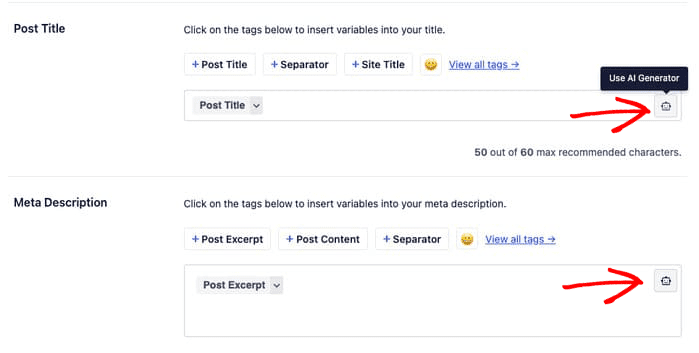
4. Optimize for the Featured Snippet
Another SEO growth hack to employ is aiming for the featured image.
A featured snippet is a SERP feature displayed at the top of Google’s search engine results page. It provides users with a direct and concise answer to their query.
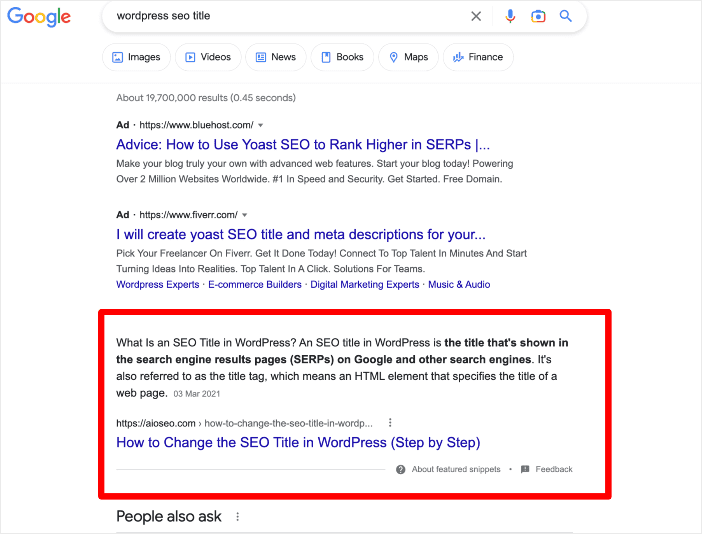
A few ways to optimize for the featured snippet include:
- Implementing schema markup
- Using a table of contents
- Adding FAQs to your content
- Optimizing your content
- Creating the best piece of content on the topic
Featured snippets are often called “position zero” because they appear above the standard organic search results.
For tips on optimizing for this coveted piece of real estate on SERPs, check out our tutorial on getting the featured snippet.
5. Get Featured in the Google’s People Also Ask (PAA) Section
Google’s People Also Ask (PAA) refers to related questions searchers may have about your particular topic, product, or service.
The PAA section of Google’s SERPs is a prominent feature that gives publishers an opportunity to bolster their visibility on search engines further. As a result, you have a chance to boost your organic traffic.
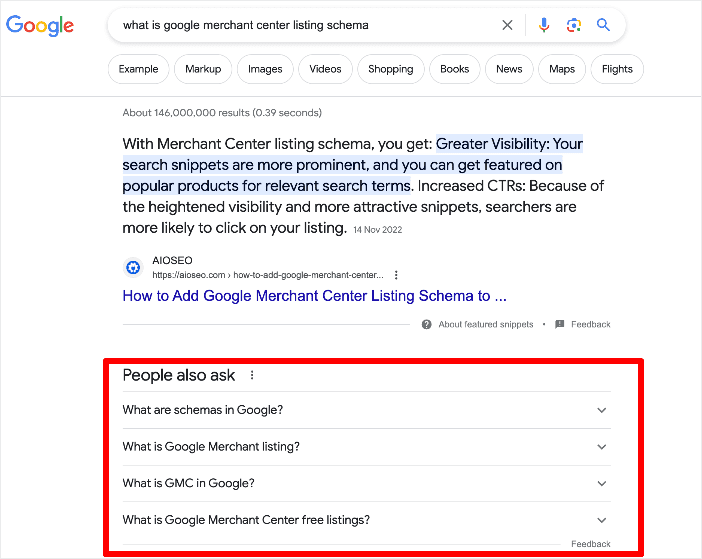
Optimizing for the PAA section also helps you bolster your semantic SEO strategy. This is because answering the common questions users ask about your primary keyword helps you create content with semantic depth. It also helps you capture traffic for long-tail keywords.
You can check out our guide to optimizing for Google’s people also ask section for step-by-step instructions.
6. Boost Your Google E-E-A-T Signals
Google E-E-A-T stands for Expertise, Experience, Authoritativeness, and Trustworthiness. It is a set of criteria Google uses to assess the quality of content on the web, particularly for pages that deal with topics related to health and finance. It’s also important for any other areas where accuracy and reliability are crucial. These are often called YMYL (your money, your life) pages/sites.
Implementing Google’s E-E-A-T content quality guidelines is easier if you have a plugin like AIOSEO. This is thanks to the Author SEO module.

This module enables you to add information to your user profiles:
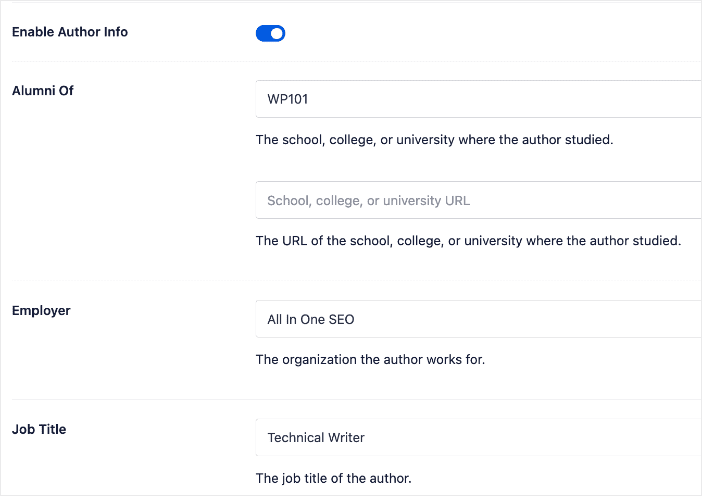
You can also add your areas of expertise:

All this information points to your experience and expertise in your field. Coupled with the JSON schema markup, it proves to search engines that you’re qualified to talk about the subject. This helps you rank higher in searches around your keyword.
All this information helps you demonstrate Google E-E-A-T, resulting in better rankings.
7. Build Strategic BackLinks
Another popular SEO growth hack is link building. However, for it to be impactful, you must do it right. The 3 types of links you should focus on are:
- Internal links
- External (outbound) links
- Backlinks
Backlinks are the more important type when it comes to generating organic traffic. These are links from external sites to your site. They are important because they serve as a vote of confidence that your site is reliable and the content valuable. A few ways of building backlinks include:
- Guest posting
- Listing on business directories
- Running outreach campaigns
Check out our link building guide for tips on building backlinks and external links
8. Combat Content Decay
Content decay is the gradual decrease in organic performance for content designed specifically for SEO. It’s a silent killer of your SEO and content marketing efforts and should be curbed as soon as possible.
Thankfully, spotting content decay is super easy with AIOSEO’s Search Statistics feature. This powerful tool shows you Google Search Console (GSC) data right inside your WordPress dashboard. And one of the insights it gives is a Content Performance report.

From the Content Performance report, you can see the Top Losing content. The Diff tab shows a proprietary point system showing the rate at which your content decays.
For more information, check out our tutorial on spotting and combatting content decay.
9. Have a Content Marketing Strategy
To further bolster your chances of driving organic traffic to your site, create a content marketing strategy. Content marketing involves creating, distributing, and promoting content for the purpose of attracting inbound traffic and leads.
A few elements to consider when designing your content marketing strategy include:
- Understanding your target audience
- Creating a content calendar for consistency
- Competitor analysis
- Checking and “stealing” your competitors’ keywords
- Creating high-quality content
- Distributing content on the right platforms
Developing a content marketing strategy will help ensure you get your content is seen by the right people. As a result, you’ll enjoy a boost in organic traffic.
10. Leverage Social Media Marketing
Social media marketing (SMM) is a digital marketing strategy that leverages social media to generate leads and grow your business. It’s also an excellent way of driving organic traffic to your site. For this to work, though, you should:
- Focus on a handful of social media platforms your target audience frequent
- Optimize your profiles to boost your visibility
- Share high-quality content
- Post consistently
- Engage with your audience
- Run giveaways using a platform like RafflePress.
Having a strong social media presence is also good, as it helps with online reputation management. If you use your social media accounts properly, you can tap into the over 5 billion users and drive traffic to your site.
2 Organic Traffic Case Studies [Plus Takeaways]
Before we wrap things up, let’s quickly look at some case studies to validate the principles and practice we just shared above.
1. Gluten-Free Food Blog Grows Organic Traffic by 508% in 3 Months
Iowa Girl Eats is a food blogger whose gluten-free living was born out of necessity. You can check out her story on her website. The website attracts a whopping 1.5 million monthly visits. But that wasn’t always the case. The website was hovering around the 400k mark for over 2 years until the blogger did a few things:
- Implemented SEO best practices like implementing recipe and review schema
- Created high-quality user-centric content targeting Google’s People Also Ask
- Obtained more backlinks
- And more
Check out the full story of how this blogger skyrocketed their organic traffic in this case study.
2. Car Seat Safety Website Grows Organic Traffic by 362% in 6 Months
Safe in the Seat is the go-to source if you need information on anything related to child car seat safety. The company was founded by Michelle Pratt in 2018.
Even though the website was launched in 2018, Semrush didn’t show any activity until December 2019. And then, it was a mere 3 visits.
But that all changed, and the blog attracted over 230K visitors between January and August of 2023.
What caused all this?
It came about using SEO hacks like:
- Creating helpful, people-first content
- Embodying Google E-E-A-T
- Implementing schema markup
- Acquiring more backlinks
Check out the full story of how this new mom exponentially grew the organic traffic to her website in this case study.
What is Organic Traffic? Your FAQs Answered
What is organic traffic?
Organic traffic refers to the visitors who come to a website through unpaid, natural search engine results. These users find the website by entering a search query into a search engine and clicking on non-paid (organic) search results.
Why is organic traffic important?
Organic traffic is important because it contributes to your site’s credibility. It’s also cost-effective over the long term and helps build a sustainable online presence. It is often associated with higher trust from users compared to paid traffic.
How can I increase organic traffic to my website?
To increase organic traffic, you should first install an effective WordPress SEO plugin like All In One SEO (AIOSEO). Next, focus on implementing SEO best practices, creating high-quality and relevant content, using relevant keywords, optimizing on-page and off-page elements, and promoting your content through social media and other channels.
What is Organic Traffic? Now that You Know, Optimize for It
Organic traffic is crucial to achieving sustainable success for your online ventures. After all, the more people you attract to your site, the higher your chances of getting customers.
We hope this post has helped you understand organic traffic and its importance to business growth. You may also want to check out other articles on our blog, like our beginners’ guide to SEO or our ultimate WordPress SEO checklist.
If you found this article helpful, then please subscribe to our YouTube Channel. You’ll find many more helpful tutorials there. You can also follow us on X (Twitter), LinkedIn, or Facebook to stay in the loop.
Disclosure: Our content is reader-supported. This means if you click on some of our links, then we may earn a commission. We only recommend products that we believe will add value to our readers.
